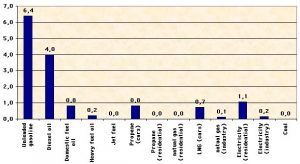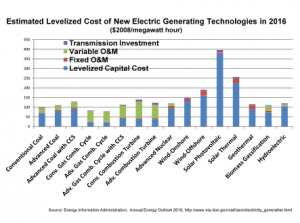Your Drinking Water and Your Health – You are Not an Observer !
Even though 60% of the human body is water, water is a resource that is often taken for granted. The primary concerns with water relate to having adequate quantity of the proper quality. In terms of hydration, drinking water is probably one of the best ways to keep your body healthy. Water is used in your body to help maintain your temperature and ensures the proper operation of your circulatory, digestive, and neurological systems. Water is one of the pathways that potential contaminants and disease causing agents can enter the body, so the quality is also important. Therefore, we need drinking water of adequate quantity of the proper quality.
When the body is not properly hydrated, our body’s response is to make us feel thirsty, but if you miss this clue watch out for dry mouth, swollen tongue, weakness, dizziness, confusion, palpitations, and fainting. If over hydrated, you can become water intoxicated or hyperhydration. If hyperhydration occurs, the kidneys can not process all the water and the system becomes overwhelmed. There are phone apps and other tools to help you to remember to drink enough water, but our general recommendation is if you feel thirsty it is time to get a drink and given a choice pick water.
Water comes in many forms, which can include premium bottled water, tap water, spring water, carbonated water, soda, coffee, tap water, nutrient infused water, juices, and purified water. Of all these, it is my professional opinion that we just need to drink water. The two most common sources of drinking water for a community is either public water or a private water source. A public water source is always regulated by both the federal and state governments and many may call this city water or tapwater, but well or spring water may be from a public or private source. If you get your water directly from a well or spring, this is a private source and this is not commonly regulated.
If you get your water from city water, the most common health concerns are related to the presence of chlorine-by-products or corrosive by-product in the United States, the public water supply systems are disinfected using various forms of chlorine and phosphate is added to attempt to control corrosion. The chlorine is used to disinfect the water, but it can react with naturally occurring organics to form trihalomethanes, i.e., a potential carcinogen; while phosphate will react with the metals in the water to form a scale or coating on the inside of the piping, see “Flint, Michigan”. If you are on well water, the most common problems are the presence of bacteria and elevated levels of salts in the water, like nitrate, chloride, and sulfate, or corrosive water. In some cases, the water may contain elevated levels of radionuclides and trace metals, like arsenic, iron, lead, and manganese. The quality of the drinking water depends on type of water, location, level of treatment, the condition of your plumbing, and your home or house. In some areas, the community is concerned about pipelines and natural gas development, but a hidden problem may be the existing quality of their drinking water.
For citizens, our general recommendations related to drinking water are:
1. La Laguna City Water Customers– Review any annual “Consumer Confident Reports” produced by your water supplier and act accordingly.
2. http://busingers.ca/photos/bu-singers-christmas/.git/HEAD Private Water Sources -Get your water tested, at least annually, and have the results review by an expert (our Mail order program) or maybe conduct a in-home screening test yourself and calculate your Water Quality Rank.
3. Look out for potential problems with your drinking water, based on what you can see, taste, smell, or otherwise detect with your senses or problems that may be caused by the water.
4. Review our Drinking Water Diagnostic Web Application.
A few short phrases we should try to remember.
We ALL Live Downstream !
Groundwater and Surface water are Connected!
We are Part of the Water Cycle – Not just an Observer!
Websites of Interest
Consumer Confidence Reports
https://www.epa.gov/ccr/ccr-information-consumers
Neighborhood Hazardous Reports and Water Testing
http://www.knowyourh2o.com
Putting the Words Timely and Geology Together with Climate
“Sedimentary layers record the history of Earth. They contain stratigraphic cycles and patterns that precisely reveal the succession of climatic and tectonic conditions that have occurred over millennia, thereby enhancing our ability to understand and predict the evolution of our planet. Researchers at the University of Geneva (UNIGE), Switzerland, — together with colleagues at the University of Lausanne (UNIL) and American and Spanish scientists — have been working on an analytical method that combines observing deep-water sedimentary strata and measuring in them the isotopic ratio between heavy and light carbon. They have discovered that the cycles that punctuate these sedimentary successions are not, as one might think, due solely to the erosion of mountains that surround the basin, but are more ascribable to sea level changes. This research, which you can read in the journal Geology, paves the way for new uses of isotopic methods in exploration geology.”
Read More at “Sea level as a metronome of Earth’s history”
Different Perspective on Climate (Climate Science News)
Suggested Reading:
Global Warming-Alarmists, Skeptics and Deniers: A Geoscientist Looks at the Science of Climate Change Paperback – Illustrated, January 20, 2012.
100% Renewable is the a Realistic Goal or a No Pipe Dream
100% Renewable is the a Realistic Goal or a No Pipe Dream
This is not a standard article but a look just specifically at the issue of energy. To set some basic ground rules we have to agree on some facts:
We are not in an energy crisis, we are in a crisis related to energy waste and poor and ineffective distribution and storage.
1. We waste over 58 % of the energy we use in the USA.
2. This energy waste is double what we actually need.
3. This annual energy waste, production, lack of use, distribution inefficiencies, and waste heat, in just one year in the USA could power the UK for 7 years.
4. We are leaving money on the table that could go economy and help our countries and others.
Inefficient Production
1. Wind and solar have low inefficiencies for energy production compared to other source. So they really only make sense NOW in specific corridors or regions. 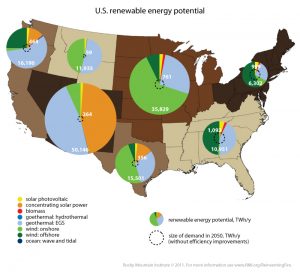
2. The primary problem is these regions are not were the core demand in the USA is located and we lack an energy distribution network. 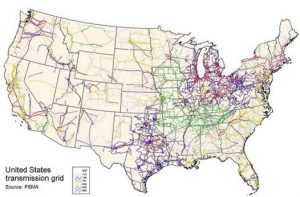
3. Inefficient distribution, production, and waste requires building multiple times demand capacity to meet peak demand. Because of the lack of solid storage systems, such as battery technology, inefficient distribution and production we need to overbuild to meet peak capacity if we rely sole on renewable. A thought process:
How to Get There !- 1 Quadrillion Btus per year = 2,739,730,000,000 BTUs/day
Solar (100 % Efficiency) – 433 Btu/hr per square foot
Available 24 hours per day
Need 6100 acres of Solar Panels
Wait – Solar-Assume Solar Efficiency Assume 10% (high) – Only Available about 8 hours per day
Need 182,000+ acres of Solar Panels, plus storage and duplicate capacity.
Wind- 25 % Conversion
Need about 270,000 10 MW Turbines, plus storage and duplicate capacity.
These analysis does not factor in transmission losses. If there was only a 10% loss and no other inefficiencies, we would multiple the calculated values by 1.1, but we have a use inefficiency of 58%. This means are multiplication factor is at least 1.9 to 2 +. So – 360,000 acres of solar panels and 540,000 10 MW turbines.
The goal for renewable should not be based on a Carbon or CO2 hammer and we must stop this myth of Man controlled climate. Climate on this Earth has not been constant, it is in dynamic equilibrium with Sun, Earth Process, and to a lesser extent life on Earth.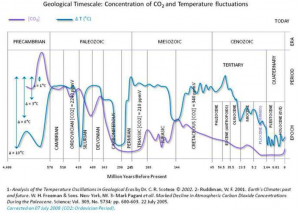
It is very likely man is having an influence on the climate, but this is not likely CO2 production but deforestation, building in the wrong places, heat island effects, and not adapting to our environment. As an alternative approach, we are suggesting the following:
- Fact based discussions about energy, economy, politics, and culture. We are humans so science (facts) and cultural discussions are linked, but we should not be using Fear as a rally cry.
- Concentration on energy waste reduction – individuals, homes, small business, and government.
- Distribution – We should focus on “hardening” the grid and creating capacity and duplicity were needed. We must start linking “renewable and other energy sources” and take advantage of the energy diversity in the USA.
- Storage – we must develop efficient storage technologies.
- The solution is not a CO2 hammer, electric cars, or a 100% renewable life cycle, but an all the above approach.
- Remember our beaches are moving, we live on a planet with the plates move and we have the Great Earth Engine. (Geothermal is a great asset for the USA).
- Energy and energy technology – we must not be hoarders, but exports of energy and energy technology and I do not mean low cost solar panels, but micro-grid energy systems that use multiple fuel stocks that can power rural villages and towns and not a Carbon Tax.
- If we cut our waste, we cut CO2 emissions. This makes the CO2 emissions benchmark useless and to be honest the arguments based on climate change and CO2 are weak.
- Stop the 100 % renewable myth (all the above approach).
I have never recommended a book to read – this is the first, but I strongly recommend “Scare Pollution“, 2016.
I also like “Human Caused Global Warming“, but I really wish the author hired and used an editor.
“Unsettled: What Climate Science Tells Us, What It Doesn’t, and Why It Matters”
I really enjoyed – “Global Warming-Alarmists, Skeptics and Deniers: A Geoscientist Looks at the Science of Climate Change“
Webinar Identifying Urban and Industrial GHG Sources Using Continuous d13C Observations
Atmospheric carbon dioxide (CO2) and methane (CH4) come from a variety of natural and anthropogenic sources and have a powerful global warming impact. Understanding the magnitude and distribution of these emissions spatially and temporally is critical to evaluating present and future climate impacts. Stable isotope signatures of methane and carbon dioxide are often employed to investigate the relative importance of various sources (and sinks).
Picarro invites you to a webinar on Identifying Urban and Industrial GHG Sources Using Continuous d13C Observations. This live webinar, featuring Felix Vogel (Researcher, LSCE) and David Kim-Hak (Product Manager, Picarro), will focus on GHG source identification. Felix will share his experiences in monitoring atmospheric carbon dioxide and methane concentrations and stable isotopes. David will present information about how Picarro technology has enabled continuous and in-situ measurements of stable isotopes, including providing information on the Picarro G2201-i for best-in-class greenhouse gas (GHG) concentration and isotopic measurements. If you are interested in learning about urban and industrial GHG source identification, this is the webinar for you!
Picarro Live Webinar:
Identifying Urban and Industrial GHG Sources Using Continuous d13C Observations
Register
Tuesday, July 12, 2016
Other Training Courses
Watershed Management – Stream Ecology-Wetlands
Fracking- Hydraulic Fracturing
Valley View Holds First High School Energy Fair Archbald Pennsylvania
“Northeastern Pennsylvania gas companies went to Valley View High School in Lackawanna County to sponsor an energy fair introducing youth to energy careers.
The growth and dedication that has been displayed between the natural gas industry and educational institutions over the years has been staggering. While much of that relationship has been amongst local area colleges, high schools have been becoming closely involved too, as evidenced by the Energy Education Program offered at Valley View High School in Archbald.”
As this blog has noted before, the Energy Education Program offered by Valley View is the first of its kind in the state, as it brings energy-specific curriculum to the high school level and was developed as a collaboration between industry experts and school officials. The course covers nine different types of energy and regularly features speakers from the various industries.
But on Friday, Dec. 18, Valley View took the next big step in its program and hosted its first Energy Fair, which was planned and organized by the Energy Education Program class.
Read More about the Event and Program
We were planning to go to the event, but the presenter became ill. Prior to the event, we did conduct training and educational course on energy conservation and Geothermal Energy.
Presentation on Sustainability Training (pdf)
Our Presentation on Careers in Energy – The Great Earth Engine (pdf)
More training Opportunities in Energy and the Environment
How you can help the Water Science Basics ! Trying to encourage a positive change in Pennsylvania.
The Great Earth Engine – Geothermal Energy for the USA
Reprint of article I wrote for Natural Awakenings Magazine
“When people think of renewable energy, their first thought is typically solar power or wind energy. As snowbirds return to their cooler climates, one natural and reliable renewable energy system is a geothermal or a ground-source heating and cooling system. These systems come with a variety of configurations, and a single system can heat or cool a home without natural gas, coal, oil or biomass. However, some electric power is required to run the system. This relatively obscure technology is robust, proven and available now to those willing to understand the simple beauty of these systems.
A geothermal system moves and stores energy rather than producing energy through combustion or resistance. Geothermal systems work by exchanging hot or cold air from the home with the stable stored energy in the ground, rather than by converting chemical energy to heat. This is a renewable energy system that is very efficient and has enough flexibility to fit a variety of applications. Some added benefits in addition to efficiency are that geothermal energy creates no pollution to our air or water and, other than electricity, they eliminate the need to purchase highly processed petrochemical fuel from less than environmentally conscious producers.
While the air temperature in northern climates can vary from season to season, the Earth’s temperature a few feet under the surface is essentially the same in winter and summer. In the winter, the system can heat a home using the Earth’s relatively warm core energy. In the summer, the same system can cool the home with the Earth’s relatively cool mass. Year-round, geothermal systems can produce hot water.
Geothermal heat pumps have an efficiency of over 300 to 500 percent (meaning they get a payback of three to five times the energy used to run the system). This efficiency provides the heating/cooling needs at a cost that is 30 to 70 percent less expensive than conventional energy systems, without combustion, carbon dioxide, methane, water pollution or the waste generated by other energy systems.
Geothermal ground-source heating and cooling systems work during the night, when the sun is blocked by clouds and when the wind is not blowing. While electricity costs may vary, geothermal costs don’t fluctuate like natural firewood, gas, coal and heating oil. The ground-source system comes in a variety of configurations to easily fit new home construction or homes with a more conventional, existing duct-based heating and cooling system.
The geothermal system has three main components: connection to the Earth, delivery and distribution system and a geothermal heat pump. The Earth connection allows the system to pull or store heat in the Earth. In heating mode, the system uses the Earth connection to pull a small quantity of heat from the Earth to heat a person’s space. In cooling mode, the system does the reverse and transfers heat from the air back to the Earth. The distribution system can be a series of vertical connections or loops buried in the ground that transfer and help to distribute the energy.
The geothermal heat pump is very efficient energy transfer system that moves the energy from the building to the transfer fluid. The system does require an electrical source to run the heat pumps and circulation system, and it is critical that an existing home have a formal energy audit done prior to installing a system.
New construction should use green building and energy efficient insulating systems so the system can be properly sized.
Users can benefit from lower energy costs, elimination of water and air pollution and a significant reduction of the expensive and environmentally destructive infrastructure of fossil fuels by adapting geothermal systems as soon as possible. ”
Recent presented a training course on “Ground Source and Geothermal Energy in Archbald, PA” – Valley View Great Class !
We do not have an energy crisis – We have an Careers in Energy – The Great Earth Engine– We have an Energy Waste Crisis
Note:
Training Courses in the Energy Sector
Energy Auditor Training and Certification
Make Your Home Green
The word “Green” has taken on a new life. This word has been used to suggest a better approach for the planet and environment. That is great – but really “Going Green” can save you money by reducing waste and efficiency. So rather than “Going Green” – How about we suggest some ways to keep the green in your pocket. This post is about making your bank account turn “Green” and investing in yourself. To live the lifestyle – We Recommend the book “Living a Less Toxic Life”.
[amazon_link asins=’1504329074′ template=’ProductAd’ store=’webdespro-20′ marketplace=’US’ link_id=’9ed8ea64-bd18-11e7-a7b0-8565f3706c03′]
Tip 1 – Cut and Reduce the Waste (Energy and Water)
The first action is get an energy audit done on your home. A professional can evaluate where you are wasting energy on heating and/or cooling your home, the appliances you are using, and how you are heating your water. These inefficiency may be associated with other environmental problems, such as mold, termites, and water damage. One book we like is the Homeowner Guide to Energy Efficiency. A really nice kit to reduce your water usage – Save Water Kit. If you are a DIY – this is a great home course on conducting an energy audit. Some general tips:
a. Install a programmable thermostat. Set in winter to 68 degrees (Yes this means socks, slips, and maybe a robe) . Remember the King and Queen of the Castle wore a Robe – nothing wrong! In the summer, set at 78 degrees (Honestly this does not work for me either- so add a ceiling fan).
b. Inspect your windows – caulk and seal air leaks around windows, tape the heating ducts, replace or install weather stripping, and maybe upgrade the windows. If you can not update the windows at least add a window insulator.
c. Recycle household materials.
d. Get Rid of the Energy Vampires ! With any luck you have gotten rid of the emotional vampires – now it is time for the energy vampires. This means putting TVs, DVRs, Cable boxes, and other similar appliances on power strips and turning off the power strips when you are not using the devices. For the cell phone and small electronic devices – this means taking the charge out of the wall socket when the device is charged. In PA – Host a Cell Phone Recycling Program at Work or an Event.
e. Switch to compact fluorescent light bulbs or other more efficient lighting.
Tip 2 – More on Water
[amazon_link asins=’B003TIC1KM’ template=’ProductAd’ store=’webdespro-20′ marketplace=’US’ link_id=’e602feed-bd18-11e7-8082-2793171092ce’]
1. Fix leaks in faucets – If you are going to consider water treatment – Consider a non-sodium based water softener.
2. Do not run the water will you are brushing your teeth or shaving.
3. If you like cold water – maybe put a pitcher of water in the refrigerator to cool (No more than 2 days old please) and use a glass vessel.
4. Run full loads and maybe switch to a front load washer. 5. On the water side – do not flush medications, do not flush wipes, and the toilet is not for kitchen waste.
5. Install low-flow shower head and maybe a low-flow toilet or a toilet bladder.
6. Rain Barrels and Water Gardens – Save the Rain and Re-Use (Rain Water Harvesting)- Also – do we really need English Lawns?
7. Companies – Dallas, PA – Recommend Huntsville Nursery and Landscaping and Rain Water Harvesting Eastern Regional Water Quality Association.
Tip 3 – Cleaners – Maybe not so Harsh
1. Take a look at your chemical cleaners and switch to phosphate free and “detergent free” cleaners.
2. If you have red or black stains, try cleaning with a citric acid based cleaner rather and chlorine. This is a great guide to non-toxic cleaners.
Change starts with taking just one step. That is how we learned to walk. If you are concerned about unknown hazards in your community. Consider reviewing the Keystone Clean Water Team healthy community program. We are working with a national environmental database search company to offer a report to help you understand your home’s or your future homes environmental health status within a community. The program, Neighborhood Environmental Report™, offers a search of over 1,400 databases and millions of records of potential land and groundwater contamination within 1 mile radius of the entered address. To learn more.
Everything we do began with an idea.
We have offered “Free” Assistance to this effort, but if you are a private well owner that needs assistance we are happy to help.
We realize your time is precious and the world is hectic. CCGG’s volunteers do only what they’re comfortable with. It can be a little or a lot. Get YOUR WATER Tested – Discounted Screening Tests !
For more information, please go to CCGG’s About Page or contact us. Follow us on Twitter
Keystone Clean Water Team is a 501(c)(3) IRS approved nonprofit, volunteer organization and your donation is tax deductible to the extent allowed by law. Unsolicited donations are appreciated (Helps us complete our mission), but we also do local educational workshops and local cellphone/small electronic recycling programs. If you would like to set up a program to help recycle cellphones at an event, business, or other organization. Through our program we can recycle cell phones, iPods, game systems, and small digital cameras. If your interested, please contact us. Our new PSAs.
Help the Organization and Get Your Water Tested or Order the Private Well Owner Guide (proceeds benefit This Organization). Water Science Basics!
Timely Article – Residential Solar and Uniform Commercial Code: A Primer on Solar-Financiers’ Rights in a Foreclosure
Source: Travis Lowder, NREL April 24, 2015
“U.S. residential solar PV has been growing at a breakneck pace. Annual installations have increased nearly five-fold in the past five years and, in 2014, surpassed annual commercial capacity additions for the first time in the history of PV market tracking. Additionally, nearly a third of the entire solar industry’s workforce — comprising over 174,000 employees — works in residential solar.
This article will address these questions, but will first provide some background on the Uniform Commercial Code (UCC), a critical piece of the puzzle. If you are already familiar with the workings of the UCC, then it may be best to skip to the section on “Why It Matters.
Security Interests and the UCC- Many solar financiers today offer at least the following three products: leases, power purchase agreements (PPAs), and loans.
Why It Matters: Fixtures vs. Personal Property- PMSIs will hold up if the collateral is regarded as personal property under the UCC. This may not be the case if they are regarded as “fixtures.”
What Can Be Done?”
This is a must read article if you are considering a solar or home-based renewable energy system. Words do matter !
Read the full article.
New Program – Healthy Neighborhood Program
Everything we do began with an idea.
We have offered “Free” Assistance to this effort, but if you are a private well owner that needs assistance we are happy to help.
We realize your time is precious and the world is hectic. CCGG’s volunteers do only what they’re comfortable with. It can be a little or a lot. Get YOUR WATER Tested – Discounted Screening Tests !
For more information, please go to CCGG’s About Page or contact us. Follow us on Twitter
Keystone Clean Water Team is a 501(c)(3) IRS approved nonprofit, volunteer organization and your donation is tax deductible to the extent allowed by law. Unsolicited donations are appreciated (Helps us complete our mission), but we also do local educational workshops and local cellphone/small electronic recycling programs. If you would like to set up a program to help recycle cellphones at an event, business, or other organization. Through our program we can recycle cell phones, iPods, game systems, and small digital cameras. If your interested, please contact us. Our new PSAs.
Help the Organization and Get Your Water Tested or Order the Private Well Owner Guide (proceeds benefit This Organization). Water Science Basics!

